NASA’s Parker Solar Probe, the winner of PopSci’s Best of What’s New in 2018, continues to achieve remarkable feats. The spacecraft has been progressively moving closer to the sun than any previous spacecraft, setting new speed records along the way. In a recent update from NASA, it was revealed that the Parker Solar Probe has once again broken its own record by becoming the fastest human-made object, reaching an incredible speed of 394,736 miles per hour.

This milestone was accomplished thanks to a gravity-assist flyby from Venus. The record-breaking event occurred during the probe’s 17th “solar encounter,” which took place from September 27 to October 3. To put this extraordinary speed into perspective, the Parker Solar Probe could hypothetically complete about 15 circumnavigations of Earth in a single hour or traverse the distance between New York City and Los Angeles in just 20 seconds. However, such a journey would be unsurvivable for human passengers, but it remains an impressive achievement.
During this recent encounter, the probe also set a new record for proximity to the sun, coming within a mere 4.51 million miles from the sun’s scorching plasma “surface.” To withstand temperatures reaching nearly 2,500 degrees Fahrenheit, the Parker Solar Probe is equipped with a 4.5-inch-thick carbon-composite shield to safeguard its sensitive instruments.
These instruments play a crucial role in measuring and imaging the sun’s surface, advancing our understanding of the origins and evolution of solar winds. Additionally, they aid in predicting changes in space environments that could impact life on Earth. In a significant event last month, the probe passed through one of the most intense coronal mass ejections (CMEs) ever observed, confirming a two-decade-old theory that CMEs interact with interplanetary dust. This discovery will enhance experts’ capabilities in forecasting space weather.
Despite the grueling conditions it encounters, NASA reports that the Parker Solar Probe remains in excellent health, with all systems operating normally. The mission is far from over, with seven more solar encounters planned through 2024. By that time, within the orbit of Mercury, the Parker Solar Probe will meet its poetic end, vaporizing into the sun’s intense solar winds, as one mission researcher described it back in 2021.



